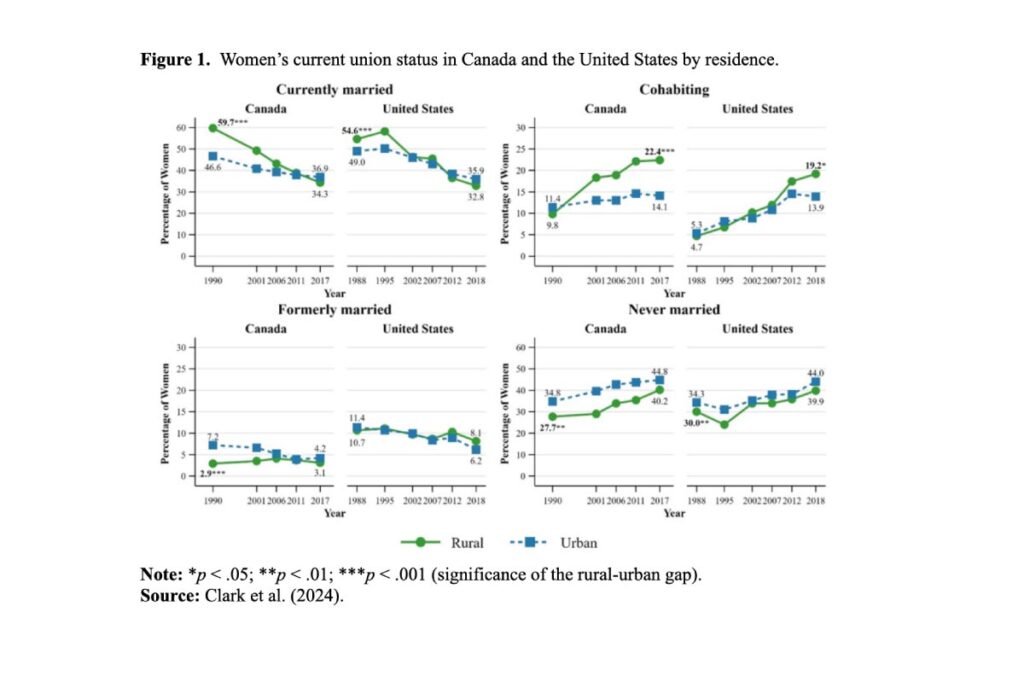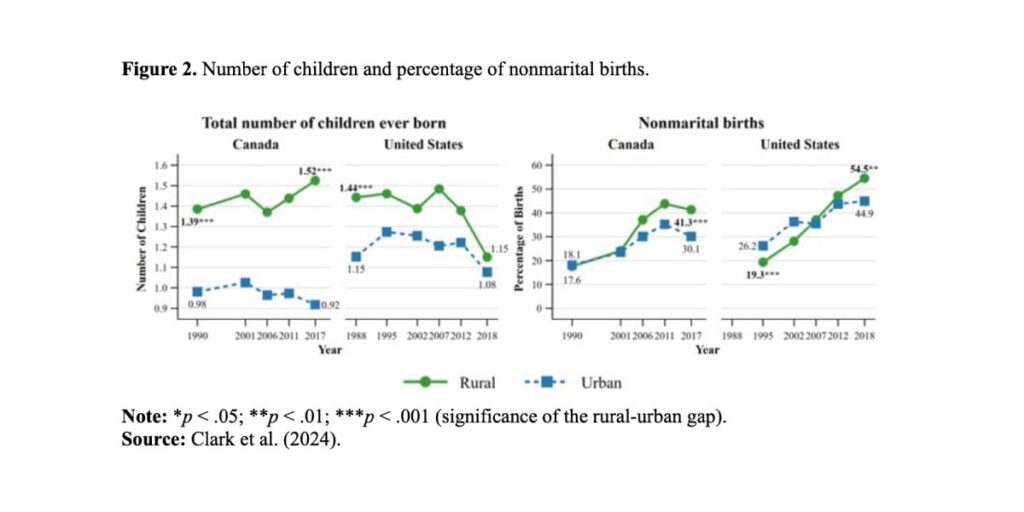What has happened to traditional two-married-parent families in rural America and Canada? Shelley Clark and Matthew Brooks explore changes in rural and urban families over the past three decades to understand why rural women are now at the vanguard of family change.
Classic demographic transition theory posited that the emergence of the “urban industrial society” transformed urban families, leading to declining fertility rates and rising ages of marriage (Notestein, 1953). In contrast, rural families were expected to maintain more traditional family behaviors, including having comparatively more children, upholding marriage as a desirable and nearly universal institution, and restricting most childbearing to within marital unions. For much of the past century and a half, family behaviors in high-income countries did, in fact, evolve more slowly in rural than in urban settings (Albrecht and Albrecht, 1996). Many demographers have assumed they will continue to do so as families in high-income countries undergo the second demographic transition characterized by sustained very low fertility rates, a pronounced retreat from marriage in favor of either remaining single or forming cohabiting unions, and a growing acceptance of having and raising children outside of marriage.
New evidence shows that these assumptions are not valid in Canada and the United States (Clark et al., 2024). In both countries, rural women are now significantly more likely than urban women to cohabit with their partners, and rural children are roughly ten percentage points more likely than urban children to be born outside of marriage. Rural fertility remains substantially higher than urban fertility in Canada, but not in the United States.
Rural families in flux: trends in union status, fertility, and nonmarital births
Rural families are often described as more traditional and more resistant to the tides of individualism and secularism that, some argue, are driving declining fertility and marriage rates and the increase in nonmarital births (Lesthaeghe, 2020). Yet, Figure 1 shows that in recent decades rural families have changed rapidly. Thirty years ago, rural Canadian and American women were significantly more likely than their urban counterparts to be married. By the late 2010s, these differences had disappeared. Perhaps even more surprising, rural women in both countries are now significantly more likely than urban women to be in cohabiting unions. In 2017, in Canada, the proportions were 22.4% and 14.1%, respectively. In the United States, in 2018, 19.2% of rural women but only 13.9% of urban women were in a cohabiting union.

Fertility rates have also fallen sharply among women in rural parts of the United States, but they have risen slightly among rural Canadian women (Figure 2), who continue to have 50% more children than their urban counterparts. As a result of these changes in union status and fertility, Figure 2 also shows sharp increases in the proportion of rural children born outside of marriage. More than 40% of rural Canadian children are born to either single or cohabiting mothers compared to roughly 30% of urban children. In the United States, well over half (54.5%) of rural children, but only 44.9% of urban children, are born outside of marriage.

Do these changes constitute a crisis for rural families?
Given the common perception that rural adults hold more conservative social and political values, these changes, particularly the decline of marriage and the increase in nonmarital births, may be cause for concern. Decades of economic decline and high rural-to-urban out migration have potentially placed many rural families under considerable strain, leading to a disconnect between rural family ideals and goals and their ability to achieve them. A decomposition analysis may help to better understand recent rural-urban differences in cohabitation and nonmarital fertility (for the details, see Clark et al., 2024).
In Canada, economic disadvantage does not seem to account for the higher levels of cohabitation or nonmarital fertility. Here, while rural women’s lower educational attainment contributes to higher rural nonmarital fertility, rural-urban differences in family behaviors largely reflect the higher proportion of ethnic minorities and immigrants in urban centers. Since the majority of Canadian immigrants are from Asia, where cohabitation, both with and without children, is uncommon, the relative absence of immigrants in rural areas plays a key role in explaining rural-urban differences in these family behaviors.
In contrast, rural families in the United States earn substantially lower incomes than urban families. Further, only a fifth of rural American women have earned a bachelor’s degree compared to a third of urban women. These differences in income and education account for most of the differences in nonmarital births. Differences in income also play an important role in elevating rural rates of cohabitation. Somewhat surprisingly, there are no statistically significant differences in religiosity, measured by the frequency of religious attendance, between rural and urban women, nor does religiosity explain differences in rural and urban family behaviors. Hence, these findings suggest that rural American women may be entering cohabiting unions and having children outside of marriage not because of their personal or religious preferences but rather because they lack the socioeconomic resources that are increasingly required to marry and remain married.
Conclusions
Our results highlight the ongoing value of studying family change through a rural-urban lens, and challenge several commonly held assumptions about rural family behaviors.
Family change is likely to be the result of multiple drivers, probably differing across contexts. In the case of the United States, addressing rural areas underlying socioeconomic disadvantage may be key to supporting both traditional and nontraditional rural families.
References
Albrecht D.E., Albrecht S.L. (1996). Family Structure Among Urban, Rural and Farm Populations: Classic Sociological Theory Revisited. Rural Sociology, 61(3), 446.
Clark S., Brooks M., Helou A.M., Margolis R. (2024) Are Rural Areas Holdouts in the Second Demographic Transition? Evidence from the U.S. and Canada. Demography. 61(2): 541–568 (DOI 10.1215/00703370-11237867)
Lesthaeghe R. (2020). The Second Demographic Transition, 1986–2020: Sub-Replacement Fertility and Rising Cohabitation—a Global Update. Genus, 76(1), 10. https://doi.org/10.1186/s41118-020-00077-4
Notestein F.W. (1953). The Economics of Population and Food Supplies. In Proceedings of the Eighth International Conference Agricultural Economics (pp. 13–31). University Press.


